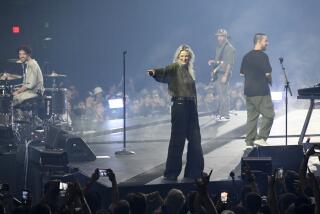Remember where you’re from
- Share via
If I were a band therapist, saving rock legends from self-destruction in stupidly expensive weekly sessions, I’d offer one key bromide to the members of Linkin Park: Dare to be who you are. Running from the past into the arms of a new image may seem necessary when a mid-life crisis afflicts -- many have done it, from Michael Jackson to Depeche Mode to Metallica to everybody’s role model, U2. But such a move only works if there’s substance beneath the semantics. And that pith almost always flows from what made you great in the first place.
That’s the case with “Minutes to Midnight,” the first proper studio album from Linkin Park since 2003’s “Meteora.” (Interim activities have included a remix project, a live DVD and a mash-up collaboration with hip-hop kingpin Jay-Z.) Hyped as a leap beyond rapcore and nu-metal -- the subgenres brought to commercial heights by these superstar sons of Agoura Hills -- the album has all the markers of a credibility move.
Reputation doctor Rick Rubin produced; the band used vintage instruments and experimented with roles throughout the recording process; DJ Joe Hahn put down his scratch bible and got more atmospheric; the first video, for the headbanging “What I’ve Done,” was shot in the desert.
Yet “Minutes to Midnight” isn’t valuable because it does away with Linkin Park’s formulas. It’s best when the band reinvests in those codes, looking for new ways to interpret them.
Certain readers might be wondering what of value might be found in rapcore and nu-metal, two of contemporary pop’s most derided subgenres. (Other equally unattractive terms for them include rap-rock, rap-metal and aggro metal.)
Both styles refreshed heavy rock a decade ago by connecting it to other styles, especially hip-hop. The indie-funk of the Red Hot Chili Peppers, the prog-rock hip-hop of Rage Against the Machine and Linkin Park’s own arty, melodic blend of post-punk and West Coast rap all fall within their parameters.
As sometimes happens when a musical style finds its lumpen proletariat, though, rapcore and nu-metal took a hit when it became the favorite music of the steroid-popping alpha dogs associated with the sexist backlash of the late 1990s. Limp Bizkit ascended, and the world rolled its eyes and turned away.
Meanwhile, Linkin Park and a few other artists kept creating music that explored how hip-hop’s turntable manipulations, cool rhyming and collage effect might connect to rock’s guitar onslaughts and howling emotionalism.
No wonder teens loved this stuff: It made a significant leap by treating their casual approach to multiculturalism as normal, and rejecting the hierarchies that declared rock more significant than hip-hop, and vice-versa.
For Linkin Park, this refusal of formal boundaries also connected to lyrical content -- Chester Bennington, the androgynous punk who can scream or croon, and Mike Shinoda, the swaggering rapper who holds his machismo close to his chest, work together to express the confusion and hope of kids for whom identity is no simple game.
Linkin Park’s members were mere lads when they made those early records, wearing their hearts on their Stussy sleeves. On “Minutes to Midnight,” these now-30ish musicians grapple with what makes a sound endure beyond the cultural confluence that inspired it.
There’s a contemplative feel throughout the album, especially on the pretty, somewhat indistinguishable ballads where Bennington fully takes the lead.
This is the kind of music artists make to find out who they’ll become next: It reaches toward many influences -- notably U2 (some songs invoke the Irish rock group almost note-for-note), but also Tool, Evanescence, Nirvana and Coldplay -- without committing to anything.
The sound finds its mojo whenever Linkin Park remembers that its music is, as Shinoda said in one interview, “the product of a new culture” -- one in which “organic” is only preferable to synthetic when you’re buying apples at Whole Foods.
Shinoda, who co-produced with Rubin, clearly enjoyed the stretch the veteran studio guru demanded.
He even tries crooning one song, “In Between,” and though it’s not a powerful vocal (and the lyrics are worse), its Postal Service-style bed of electronics is pretty interesting. When Shinoda does rap, he really delivers.
A lefty-activist focus sparks the relaxed delivery he’s developed in his other group, Fort Minor, and in “Hands Held High” he goes a step further than the average pop protest song, not just shouting “No more Bush,” but asking his fans to question why they snicker at the news instead of taking action.
“Minutes to Midnight” becomes more ponderous when it becomes a bid for the Rock and Roll Hall of Fame, with Bennington brooding about heartbreak and social injustice over Brad Delson’s soaring guitars and Rob Bourdon’s rolling, martial (read: U2-like) drums.
These earnestly, artfully derivative songs don’t show enough love for what makes Linkin Park compelling. Hahn’s electronics, for example, are sometimes so underplayed that you want to reach into your stereo and yank them out. That’s a mistake.
Some songs do get the balance right. “Leave Out All the Rest,” a meditation on mortality destined for innumerable MySpace memorial pages, features the group’s layering technique at its most gorgeous -- a Moog-ish synthesizer lick is topped by a bubbling percussion loop; live drums and bass add warmth, and Bennington’s angry-choirboy vocals build until everything intertwines in a gently compressed chorus.
Such careful constructions shine a light on how Linkin Park might continue to mature, by remembering the therapeutic wisdom of comedian Al Franken’s creation Stuart Smalley: They’re good enough, they’re smart enough and darn it, people really like them.
---
Linkin Park
“Minutes to Midnight”
** 1/2
Albums are reviewed on a scale of four stars (excellent), three stars (good), two star (fair) and one star (poor).
More to Read
The biggest entertainment stories
Get our big stories about Hollywood, film, television, music, arts, culture and more right in your inbox as soon as they publish.
You may occasionally receive promotional content from the Los Angeles Times.










